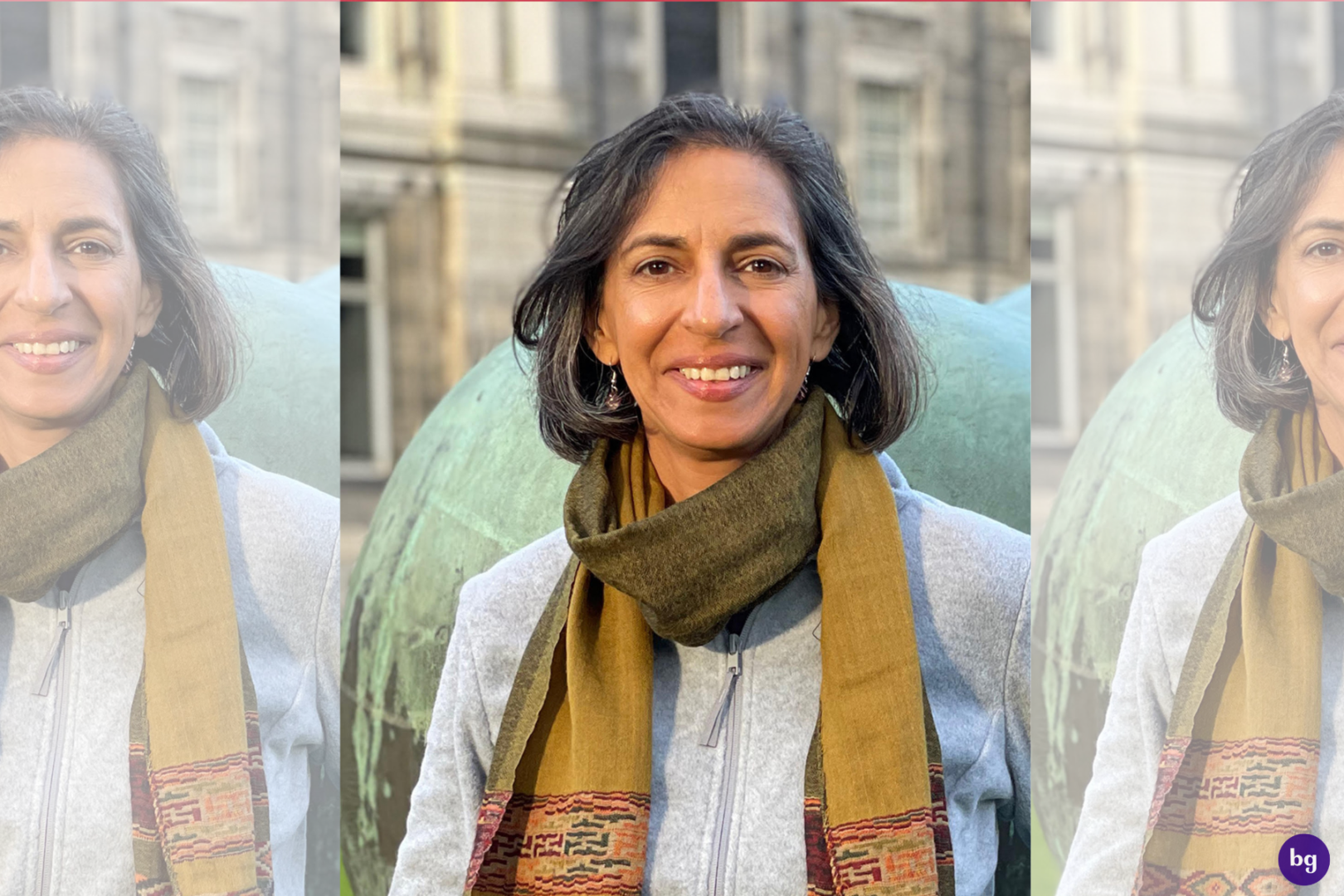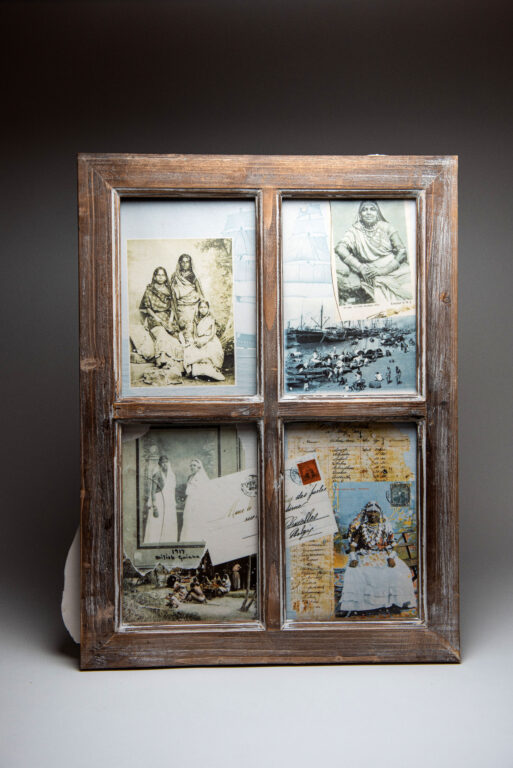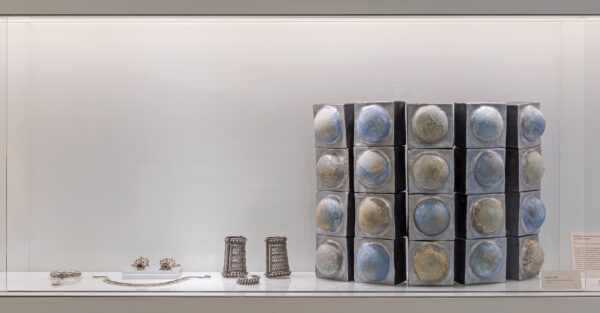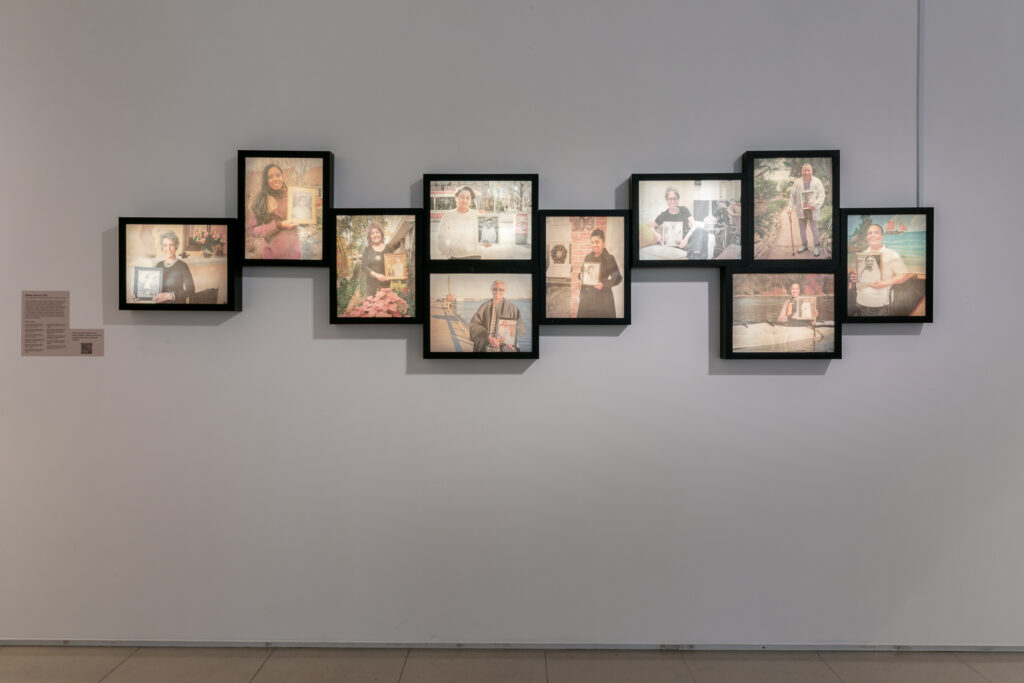
Multimedia artist Heidi McKenzie highlighted themes of ancestry, race, migration and colonization through a feminist lens in her solo exhibition, titled “Reclaimed: Indo-Caribbean HerStories,” held at the Gardiner Museum in Toronto in 2023. Indo Caribbean history is largely unknown given limited historical documentation. Relatives provide puzzle pieces to lineage through oral accounts passed down from preceding generations. But McKenzie not only did justice to her family’s history by piecing together these fragments but also created space to engage with their identity in a communal setting.
The Artist
Growing up in the city of Fredericton in New Brunswick, Canada, McKenzie grappled with finding representation as her father was an Indo Trinidadian immigrant, and her mother was Irish American. In the 1950s, her parents married during a time when interracial marriages were illegal in several American states and were uncommon in Canada.
[Read Related: Trinidadian Artist Renluka Maharaj: A Fresh Take on Indian Indentureship Through Art ]
Like many Indo Caribbean families, McKenzie’s father did not know of his ancestors’ tribulations. Seeds of curiosity about her father’s ancestors were planted when she met a cousin for the first time at the University of Toronto’s Caribbean Christmas Party. McKenzie’s journey to discover her ancestors began with her first tangible clue — an image of her great-great-grandmother, Roonia.

Intrigued by her Indo Caribbean lineage, she sought answers. She read the literature of Ramabai Espinet’s “The Swinging Bridge” and later Gaiutra Bahadur’s “Coolie Woman.” During the pandemic, McKenzie contacted a cousin residing in the United Kingdom. Gathering puzzle pieces of their lineage, they secured birth and death records, marriage certificates, deeds and other archival essentials. On his trip to Guyana in November 2022, her cousin found emigration passes belonging to Roonia and her husband, Rashid al-din Machedine.
McKenzie grew up believing her great-great-grandfather Rashid al-din Machedine was an Afghani Muslim. But based on clues and research, McKenzie discovered that Roonia and Rashid al-din Machedine were considered low-caste Hindus and that Rashid al-din Machedine’s name was actually Ramgoolam. Roonia’s vague history, however, left much to wonder as history is known to have minimized the presence of women.
“I have come to expect the unexpected, and complex layers of different realities in the aural story-telling of family lore and history. I just had to ‘displace’ my idea of Roonia as most likely having been a widow. However, that said, it’s still possible that she was a widow at a very young age, [perhaps] nine or 10 years of age, as this might not have been so uncommon in India at that time,” McKenzie said.
McKenzie devoted time to understanding her personal history and the history of others. Through her ceramics career, she gained unique perspectives on how people from different cultures live. She credits her partner, Ali Kazimi, whose work has profoundly impacted her life.
“I met my soulmate and life partner, Ali Kazimi, 30 years ago this fall. His professional career as a social justice, anti-racism activist has had a profound impact on my life, my worldview, and my artistic practice. Ali, among many things, continues to teach me to think critically about the world, and to always be curious.”
The Exhibition
While past historians neglected women’s stories, McKenzie’s exhibition is dedicated to showcasing the stories of Indo Caribbean foremothers. “Reclaimed: Indo-Caribbean HerStories” comprises of three main elements: ceramic sculptures paired with historical jewelry, contemporary portraits printed on translucent porcelain, and archival images on porcelain suspended in frames.

The exhibit also incorporates a collage of “Coolie Belles,” inspired by turn-of-the-century postcards that were viewed through a colonized patriarchal lens. During this period, most women lacked access to education and banks. Despite their predominantly illiterate status, these resourceful women used their wealth to create jewelry to adorn their bodies.
The contemporary portraits were part of a long-awaited opportunity to utilize lightboxes with photography on porcelain. The process of selecting individuals for the lightboxes was intentional. Key figures include celebrated writer Ramabai Espinet, political activist Kamala Jean Gopie, Cheryl Khan, and Lancelyn Rayman-Waters amongst others. The selections represent a diverse spectrum of women with varying occupations, ages and nationalities.

In her previous exhibit, “Holding Ancestry,” McKenzie incorporated images of ships that transported indentured workers. She draws attention to the anonymity of the women, who were labeled as “the Hindoo types” or “Coolie Belles,” conveying the erasure of their personal identities through a colonial lens. McKenzie hoped audience members would empathize with these women or at least be prompted to ponder the ornate adornment of women’s jewelry and question who exploited these images on the other side of the camera.

The Goal
In 2022, McKenzie emerged as a Shantz Award finalist and received the FUSION Clay & Glass Award of Achievement, and was inducted into the International Academy of Ceramics in Geneva, Switzerland. Her artistic journey has traversed numerous countries, including India, Denmark, Hungary, Australia, China and Indonesia.
While her path to a successful career was not without challenges, McKenzie recalls hearing her life’s calling at 40.
When I turned 40, my parents presented me with a grade three school assignment I wrote called ‘All About Me.’ One of the chapters described in detail, complete with hand-drawn illustrations, that I was going to be a potter when I grew up. I had completely forgotten. I didn’t even take art in high school! A few months later, I was in India, apprenticing with one of the top studio potters in the country. Doors just opened up when I had clarity in my life — until that time, my career had been a tumbleweed; rewarding and good work, but no sense of focus.
McKenzie transitioned from the radio station to becoming a full-time artist. But her use of pottery goes beyond representing historical stories. It is a tool of self-expression. Pottery was also a means of coping with her father’s death.
During the pandemic, McKenzie found inspiration in sculpting, driven by a desire to share stories through her art. This shift in focus came after reflection. She recognized it as an opportunity to challenge people’s perceptions and broaden their view of the world. Her goal is to foster a sense of community with a shared history or understanding of Indo Caribbean women’s historical journeys.
Community, thinking, learning, pushing the boundaries, and being in an international arena with peers and mentors, is where I thrive. Making art is a solitary activity — and solitude is necessary to create. I need to balance solitude with community, and continue to renew my inspiration through my colleagues’ works, ideas and research.

McKenzie is currently working on creating a tapestry featuring portraits from “Holding Ancestry” using archival family photographs from featured women’s families. It will be featured in the second edition of the Indian Ceramics Triennale, taking place from January to March 2024 in New Delhi. She is one of 34 artists from around the world who will participate.
The “herstories” of these women will be on video display. She emphasizes the significance of bringing the Indian diaspora to a full circle by showcasing their voices in India at an event where tens of thousands of people will have the opportunity to see, learn and understand the little-known stories of Indian indentureship in the Caribbean.
[Read Related: Culture Series Part 3: Remembering Indentureship Through art in Suriname, Guyana and Trinidad]
“Holding Ancestry” and “Looking Back” are currently on display at Ruth Chandler Williamson Gallery in Claremont, California, as part of the group exhibition titled “The Feeling of Being Brown” from January 27 to April 7, 2024.
You can learn more about Heidi McKenzie and her work here.




